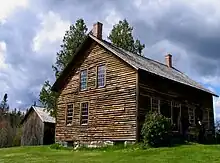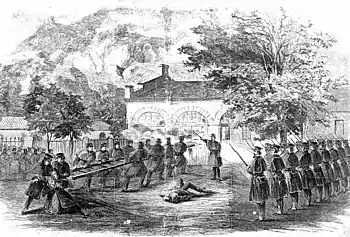约翰·布朗 (废奴主义者)
约翰·布朗(John Brown;1800年5月9日—1859年12月2日),美国起义领袖、废奴主义者,1856年曾参加堪萨斯内战,赢得胜利。1859年他率众在哈伯斯费里舉事,要求废除奴隶制,并逮捕一些莊園主,解放了许多奴隶。舉事失利,布朗被捕并被處絞。
| 约翰·布朗 | |
|---|---|
 | |
| 出生 | 1800年5月9日 |
| 逝世 | 1859年12月2日(59歲) |
| 死因 | 处决 |
| 墓地 | John Brown Farm and Gravesite |
| 知名于 | Pottawatomie Massacre Raid on Harpers Ferry |
| 儿女 | 20人(11人活到成年) |
约翰·布朗最开始在血濺堪薩斯危机中引起了注意力。不像大多数北方人认为应该通过和平手段,以談判模式,協調解决奴隶制废存问题,约翰·布朗认为应该采取暴动。他说:“这些人只會空嘴薄舌。我们需要的是行动,行动!”("These men are all talk. What we need is action - action!") [1]
在1856年5月堪萨斯的运动中,他和同伴杀害了5名南方奴隶主。1859年他在弗吉尼亚州哈珀斯费里发动起义,7人(包括一名黑人)丧生,10余人受伤。3天之后,他的同伴多被杀害,起义被罗伯特·李将军镇压,約翰·布朗自己亦被逮捕并處決。約翰·布朗的死成为了引发南北战争的重要原因之一。
早年
约翰·布朗生于1800年5月9日。他是欧文·布朗的第4个孩子。1805年,举家搬至俄亥俄州哈德逊。约翰·布朗16岁离家,来到麻塞诸塞州(麻省)学习。1820年娶了Dianthe Lusk。他们的第一个孩子小约翰,在13个月后出生。1825年搬迁至里士满,买了200公顷的地。他雇人养牲畜,修了一个粮仓。1831年,他的一个儿子死了,约翰·布朗生病了,他的事业也一落千丈,并陷入了债务中。1832年夏天,他又一个新生儿死去,他的妻子随之也死了。1833年6月14日,他娶了当时16岁的玛丽·安·戴(1817.4.15-1884.5.1),他们共有13个孩子,加上先前婚姻的7个孩子,约翰·布朗总共有20个孩子。
1836年,约翰·布朗搬迁至俄亥俄州的肯特,在那里他借钱买了土地。在1839年的经济危机中,他蒙受了巨大的经济损失。西部州损失惨重。在当时借钱成风的背景下,许多像约翰·布朗一样的商人过于充满信心,都尝到了苦果。约翰·布朗甚至与另一个人争夺农场的所有权而被送进监狱。像那时很多跟他背景相似的人一样,约翰·布朗也想通过经商来还清债务。他从事牲口交易和马、羊的饲养。他喂羊的故事后来成为了他成名之后的一件佚事。1837年,为回应Elijah P. Lovejoy被谋杀事件,约翰·布朗公开发誓:“在这里,在上帝面前,在这些见证者面前,从我一生的这时起,我将我的生命献给废除奴隶制度的伟大事业!”(“Here, before God, in the presence of these witnesses, from this time, I consecrate my life to the destruction of slavery!”)1842年9月28日,布朗被一家联邦法院宣判破产。
1843年,他的4个孩子死于痢疾。小路易斯德卡洛在他的传记中表示[2],1840年中期,布朗成为了有名的绵羊及羊毛专家,并且与俄亥俄州阿克伦城的西蒙·珀金斯建立了合作关系,由布朗和儿子管理羊群和农场。 布朗最终搬入与珀金斯丘的珀金斯的豪宅一街之隔的一套房内。 两套房仍然由山顶县历史协会拥有并管理。当约翰·布朗在地区内牧羊人中声望渐起时,他的企业常被农业杂志提到,甚至引起了对羊毛的关注。这事经常使他和其他狂热的废奴主义者互相联系。1846年约翰·布朗和Perkins在麻省的春田开办了一家羊毛厂,以抵制新英格兰的占主导地位的羊毛厂。约翰·布朗开始天真地相信那些生产者,但后来发现这些人就想控制产品的价格。这些人无组织无纪律,不思进取。


堪萨斯的活动
晚年
起义

1859年7月3日,布朗到达了哈伯斯费里。几天后,他以艾萨克·史密斯的名义租赁了马里兰州附近的肯尼迪农场,在那里,他等待着他士兵的到来。
- 被殺死人物
|
John Anderson |
Lewis Sheridan Leary |
Stewart Taylor (died of wounds) |
- Hanged in 1859 following the raid
|
John Brown |
Edwin Coppac |
- Hanged in 1860
Albert Hazlett
Aaron D. Stevens
- 美國內戰期間死亡
Barclay Coppock
Charles Plummer Tidd
- 生還者
Osborn Perry Anderson
Owen Brown
Francis Jackson Meriam
逝世
参考
次级来源
- Ken Chowder, "The Father of American Terrorism." American Heritage (2000) 51(1): pp 81+; online version
- DeCaro, Louis A. Jr. "Fire from the Midst of You": A Religious Life of John Brown (2002)
- W.E.B. Du Bois John Brown (ISBN 978-0-679-78353-4) (1909).
- Finkelman, Paul ed. His Soul Goes Marching On: Responses to John Brown and the Harpers Ferry Raid (1995)
- Goodrich, Thomas War to the Knife: Bleeding Kansas, 1854-1861 (1998).
- Malin, James. John Brown & the Legend of Fifty-Six (1942), the most influential scholarly attack on Brown (ISBN 978-0-8383-1021-2)
- Nevins, Allan. Ordeal of the Union. 2 vols. (1947), in depth scholarly history.
- Nichols, Roy F. “The Kansas-Nebraska Act: A Century of Historiography.” Mississippi Valley Historical Review 43 (September 1956): 187-212. Online at JSTOR (also paper) at most academic libraries.
- Nudelman, Franny, John Brown's Body: Slavery, Violence, and the Culture of War (2004).
- Oates, Stephen B. To Purge This Land With Blood: A Biography of John Brown (1970).
- Oates, Stephen B. Our Fiery Trial: Abraham Lincoln, John Brown, and the Civil War Era (1979)
- Peterson, Merrill D. (2002): John Brown: The Legend Revisited (ISBN 978-0-8139-2132-7), how history has treated Brown
- Potter, David M. The Impending Crisis, 1848-1861 (1976), prize winning scholarly history of the era
- Renehan, Edward J. The Secret Six: The True Tale of the Men Who Conspired with John Brown. 1995.
- Reynolds, David S. (2005): John Brown, Abolitionist: The Man Who Killed Slavery, Sparked the Civil War, and Seeded Civil Rights (2005) a favorable biography; says (p. 8): "My stand on some key issues is: (a) Brown was not insane; instead, he was a deeply religious, flawed, yet ultimately noble reformer; (b) the Pottawatomie affair was indeed a crime, but it was a war crime committed against proslavery settlers by a man who saw slavery as an unprovoked war of one race against another; and (c) neither Brown's provisional constitution nor the Harpers Ferry raid were wild-eyed, erratic schemes doomed to failure; instead, they reflect Brown's overconfidence in whites' ability to rise above racism and in blacks' willingness to rise up in armed insurrection against their masters."
- Rodriguez, Junius P., ed. Encyclopedia of Slave Resistance and Rebellion. Westport, CT: Greenwood, 2006.
- Otto Scott, The Secret Six: John Brown and The Abolitionist Movement (1979).
- SenGupta, Gunja. “Bleeding Kansas: A Review Essay.” Kansas History 24 (Winter 2001/2002): 318-341. (页面存档备份,存于)
- Villard, Oswald Garrison, John Brown 1800-1859: A Biography Fifty Years After (1910). full text online (页面存档备份,存于)
主要来源
- Louis Ruchames, ed. A John Brown Reader: The Story of John Brown in His Own Words, in the Words of Those who Knew Him (1959)
- Franklin Sanborn (ed.) (1891): The Life and Letters of John Brown
- DeCaro, Louis A. Jr. John Brown--The Cost of Freedom: Selections from His Life & Letters (New York: International Publishers, 2007)
- Henry David Thoreau (1859): A Plea for Captain John Brown
- Andrew Johnson (1859): What John Brown Did in Kansas (December 12, 1859): a speech to the United States House of Representatives, December 12, 1859. Originally published in The Congressional Globe, The Official Proceedings of Congress, Published by John C. Rives, Washington, D. C. Thirty-Sixth Congress, 1st Session, New Series...No. 7, Tuesday, December 13, 1859, pages 105-106. Retrieved May 16, 2005.
在线文档
- "John Brown's body and blood" (页面存档备份,存于) by Ari Kelman: a review in the TLS (页面存档备份,存于), February 14, 2007.
- John Brown Museum State Historic Site Osawatomie, Kansas
- What John Brown Did In Kansas (页面存档备份,存于) Battle of Osawatomie, 1856
- John Brown, Abolitionist, by David Reynolds, 2005
- West Virginia Archives and History
- Project Gutenberg: John Brown's Body (1928) (full text) (页面存档备份,存于)
历史小说
- Olds, Bruce. Raising Holy Hell (1995).
- Banks, Russell. Cloudsplitter (1998).
- Ehrlich, Leonard. God's Angry Man (1932).
- Bisson,Terry Fire on the Mountain (1988)
- George Macdonald Fraser "Flashman and the Angel of the Lord" (1994)
- Rinaldi, Ann. Mine Eyes Have Seen. (1997)
- Cliff, Michelle. Free Enterprise. (1993)
- Brooks, Geraldine. March: A Love Story in a Time of War (2006)
- Flint, Eric. "1824: The Arkansas War" (2006)
- Santa Fe Trail (film). (1940)
- Summers, Kevin G. "His Soul Goes Marching On" in Tales of Moreauvia, Issue One (2008).
- Pulitzer Prize for Poetry, 1929: Stephen Vincent Benet, John Brown's Body
- John Brown's Body (originally known as "John Brown's Song"), Union marching song of the American Civil War.
外部链接
- Find-A-Grave profile for John Brown (页面存档备份,存于)
- New York History Net, John Brown's Farm (页面存档备份,存于)
- John Brown's pike, Kansas Museum of History (页面存档备份,存于)
- John Brown's surveying compass, Kansas Museum of History (页面存档备份,存于)
- Collection of John Brown's Letters (页面存档备份,存于)
- Interview with David S. Reynolds author of John Brown, Abolitionist: The Man Who Killed Slavery, Lindenhurst Memorial Library BookTalk
- John Brown's pedigree (页面存档备份,存于)
- John Brown's Gravesite - North Elba, NY (页面存档备份,存于)
注释
- Rhodes, James Ford. . Original from Harvard University: Harper & Brothers. 1892: 385.
- (小路易斯德卡洛,2007)
- Frederick J. Blue in American Historical Review (April 2006) v. 111 p 481-2.
- David Potter, The Impending Crisis, pages 378-379
- David Potter, The Impending Crisis, pages 356-384 - Potter said the emotional effect of Brown's raid was greater than the philosophical effect of the Lincoln-Douglas debates, and that his raid revealed a deep division between North and South.